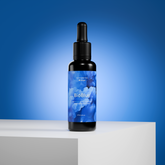Sleep
How does RLT help?
Studies show that red/NIR light therapy (RLT) has a positive impact on the hormone produced by your pineal gland in the brain that promotes sleep, melatonin. Not only can this assist individuals that are experiencing poor quality of sleep (ie, trouble falling asleep, fragmented sleep, etc.), but RLT can also dramatically benefit quality and quantity of sleep in insomniacs.

Tell me more...
Once again, we only have to look as far as our tiny friends, the mitochondria, to understand how RLT benefits our overall health and wellness. In this particular instance, how they improve (or worsen) the quality of our sleep.
While most people are familiar with melatonin as the sleep-inducing hormone, it is well understood in the human biology world that this hormone is also paramount for optimal mitochondrial function. In essence, melatonin protects mitochondria from damage and is essential for mitochondrial regeneration while we sleep.
Digging a little deeper, melatonin benefits our mitochondria by: preventing free radical damage; regulating and maintaining the bioenergetic function and respiratory activities, electron transport chain, and ATP production; acting as a neuroprotectant for the brain by preventing oxidative stress that is commonly seen in Parkinson's, Alzheimer's and Huntington's disease; and potentially contributing to anti-aging.
Lastly, all melatonin is not necessarily derived from the pineal gland in the brain. The presence of melatonin has been detected in many different extra-pineal tissues including the brain, retina, lens, cochlea, Harderian gland (eyes), airway epithelium, skin, gastrointestinal tract, liver, kidney, thyroid, pancreas, thymus, spleen, immune system cells, carotid body, reproductive tract, and endothelial cells.
This presents the possibility that whole-body red/NIR light irradiation could potentially therapeutically effect melatonin production and not just the brain (via the pineal gland).

What does the research show?
“After five days of PBM therapy targeting the prefrontal cortex, sleep efficiency and N-back cognitive performance were improved on the fifth day.” (1)
"A review of the literature suggests that not only retinal, but also whole-body and intranasal irradiation with red light leads to a notable increase in serum melatonin levels in humans." (2)
"Our study confirmed the effectiveness of body irradiation with red light in improving the quality of sleep of elite female basketball players and offered a non-pharmacologic and noninvasive therapy to prevent sleep disorders after training.” (3)
"Red light (610 and 660nm) has no effect on melatonin suppression and slightly shortens the time before dim light onset of melatonin secretion." (4)
"The 14-day whole-body irradiation with red light treatment improved the sleep, serum melatonin level, and endurance performance." (5)
**While the current scientific research seems to indicate many positive benefits of RLT in relation to improving sleep health, there is still an appreciable necessity for more extensive research to be conducted in this area, including double-blind RCT (randomized controlled trials), to provide a more comprehensive, robust overview that will further elucidate the optimal parameters and appropriate uses of RLT, which will ultimately lead the most safe and efficacious uses for individuals dealing with poor sleep or other sleep disorders.
Citations
(1) Zhao, Xing et al. “Brain Photobiomodulation Improves Sleep Quality in Subjective Cognitive Decline: A Randomized, Sham-Controlled Study.” Journal of Alzheimer's disease : JADvol. 87,4 (2022): 1581-1589. doi:10.3233/JAD-215715
(2) Odinokov, D., & Hamblin, M. R. (2018). Aging of lymphoid organs: Can photobiomodulation reverse age-associated thymic involution via stimulation of extrapineal melatonin synthesis and bone marrow stem cells? Journal of Biophotonics, 11(8), e201700282. doi:10.1002/jbio.201700282
(3) Zhao, Jiexiu et al. “Red light and the sleep quality and endurance performance of Chinese female basketball players.” Journal of athletic training vol. 47,6 (2012): 673-8. doi:10.4085/1062-6050-47.6.08
(4) Yeager, R. L., Oleske, D. A., Sanders, R. A., Watkins, J. B., Eells, J. T., & Henshel, D. S. (2007). Melatonin as a principal component of red light therapy. Medical Hypotheses, 69(2), 372–376. doi:10.1016/j.mehy.2006.12.041
(5) Zhao, Jiexiu et al. “Red light and the sleep quality and endurance performance of Chinese female basketball players.” Journal of athletic training vol. 47,6 (2012): 673-8. doi:10.4085/1062-6050-47.6.08







